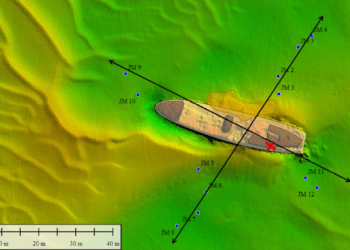
Sir Ernest Shackleton, the pioneering Antarctic explorer, is most famous for his daring leadership during the Endurance expedition, where he miraculously led his crew to safety after their ship became trapped in ice. However, another of his ships, The Quest (aboard which he would eventually die), played a significant role in his later expeditions. And it has recently been discovered in the Labrador Sea, off the coast of Newfoundland, Canada.
The discovery of the shipwreck was made last Sunday by a team from The Royal Canadian Geographical Society (RCGS). Alexandria Shackleton, Shackleton’s granddaughter, called it “the last discovery in the Shackleton story.”
Shackleton’s Pioneering Legacy

Sir Ernest Shackleton’s name is synonymous with courage and perseverance. His Antarctic adventures have captivated the world for over a century.
Born on February 15, 1874, in County Kildare, Ireland, Shackleton moved to London with his family as a child. His fascination with the sea led him to join the merchant navy at 16. By his early twenties, he had become a seasoned sailor.
Then, in 1901, Shackleton joined Captain Robert Falcon Scott’s Discovery Expedition to Antarctica. Although he fell ill and had to return home early, the experience ignited his passion for polar exploration.
Shackleton’s most famous voyage was the Imperial Trans-Antarctic Expedition (1914-1917), aboard the ship Endurance. The plan was to cross the Antarctic continent from coast to coast. However, the Endurance became trapped in pack ice and eventually sank.

Shackleton’s leadership during this crisis was nothing short of remarkable. He kept his crew’s morale high and ensured their survival through the long Antarctic winter. After months on the ice, Shackleton led a daring open-boat journey to South Georgia Island, seeking rescue. His unwavering resolve saved every crew member, later earning him a knighthood.
The wreck of Endurance was found only recently, 107 years after the ship sank. It was discovered just a few kilometers from where it was abandoned after a search mounted by the Falklands Maritime Heritage Trust (FMHT) investigated the area for two weeks. Despite lying under 3 km (10,000 feet) of frigid water for over a century, Endurance seems in impeccable shape for a shipwreck, almost frozen in time — much like The Quest, but more on that in a moment.
The Fateful Final Voyage

In 1921, Shackleton embarked on what would be his final expedition. This time, his ship was The Quest — originally the “Foca I” but renamed by Lady Shackleton. The mission aimed to explore the Arctic and Canadian waters. They intended to study the weather, wildlife, and natural resources of the region. Shackleton believed that this expedition would reveal large undiscovered land masses that “would be of the greatest scientific interest to the world, apart from the possible economic value”
However, the plan was abandoned after Shackleton failed to secure financial support. Thereupon the captain switched his attention back to Antarctica. Yet, the expedition never achieved its goals.
On January 5, 1922, while the Quest was moored in South Georgia, Sir Ernest Shackleton suffered a fatal heart attack, at only 47 years old. This marked the end of the Heroic Age of Exploration. His death was the only one ever to occur on a Shackleton expedition, even though his crews often had to endure some of the most unforgiving situations with low odds of survival.
After Shackleton’s death, the Quest expedition continued under the command of Frank Wild, Shackleton’s second-in-command. But despite the crew’s best efforts, the expedition faced numerous challenges, including harsh weather conditions, mechanical problems, and a generally inadequate ship.
The Quest was slow, guzzled a lot of fuel, suffered from repeated leaks, and had the tendency to roll in heavy seas. The expedition to the eastern Antarctic quietly ended and the 1280-foot ship was ordered home to England by the financier John Quiller Rowett.

The Quest eventually returned to England where it was refitted for other missions. The ship famously rescued the Italia Arctic airship crash survivors in 1928 and later served as the primary expedition vessel from London to eastern Greenland for British Arctic explorers. And, during World War II, the Quest was turned into a minesweeper and light cargo vessel.
Discovery of The Quest Shipwreck
After the war, the Quest returned to its original purpose as a sealer (a seal-hunting vessel) and did so for decades. Then, on May 5, 1962, while on one of its regular seal-hunting expeditions, The Quest was pierced by ice and sank in the Labrador Sea. Luckily, the crew survived and were rescued.

The exact location of The Quest’s shipwreck had been an enigma due to shifting currents and confusing records. That’s until researchers at the Royal Canadian Geographical Society (RCGS) led by John Geiger set on the quest to find Shackleton’s last ship.
“Finding Quest is one of the final chapters in the extraordinary story of Sir Ernest Shackleton,” Geiger said in a press statement. “Shackleton was known for his courage and brilliance as a leader in crisis. The tragic irony is that his was the only death to take place on any of the ships under his direct command.”

Using historical maps, modern charts, and side-scan sonar technology, the researchers managed to locate the shipwreck at a depth of 1,280 feet. Remarkably, the ship remains largely intact, with only the main mast broken.
“My grandfather, Sir Ernest Shackleton, had purchased Quest with the intention of leading a Canadian Arctic expedition,” said Alexandra Shackleton, Sir Ernest’s granddaughter and co-patron of the Shackleton Quest Expedition. “It is perhaps fitting that the ship should have ended its storied service in Canadian waters. I have long hoped for this day and am grateful to those who made this incredible discovery.”
According to the researchers, the ship will stay undisturbed due to its location in a protected wildlife area. Future plans include photographing the ship with a remotely operated vehicle to assess its condition more thoroughly.






